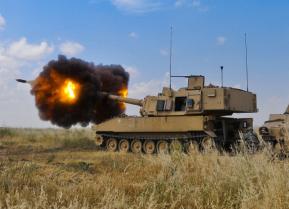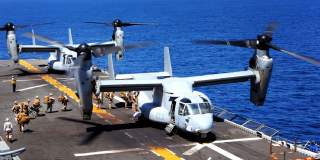This Might be the Marines Ultimate Weapon: Osprey's Armed with Lots of Firepower
The Marine Corps is now arming its Osprey tiltrotor aircraft with a range of weapons to enable its assault support and escort missions in increasingly high-threat combat environments.
Adding weapons to the Osprey would naturally allow the aircraft to better defend itself should it come under attack from small arms fire, missiles or surface rockets while conducting transport missions; in addition, precision fire will enable the Osprey to support amphibious operations with suppressive or offensive fire as Marines approach enemy territory. Furthermore, weapons will better facilitate an Osprey-centric tactic known as "Mounted Vertical Maneuver" wherein the tiltrotor uses its airplane speeds and helicopter hover and maneuver technology to transport weapons such as mobile mortars and light vehicles, supplies and Marines behind enemy lines for a range of combat missions -- to include surprise attacks.
The Marine Corps is now arming its Osprey tiltrotor aircraft with a range of weapons to enable its assault support and escort missions in increasingly high-threat combat environments.
Rockets, guns and missiles are among the weapons now under consideration, as the Corps examines requirements for an “all-quadrant” weapons application versus other possible configurations such as purely "forward firing" weapons.
“The current requirement is for an allquadrant weapons system. We are re-examining that requirement—we may find that initially, forward firing weapons could bridge the escort gap until we get a new rotary wing or tiltotor attack platform, with comparable range and speed to the Osprey,” Capt. Sarah Burns, Marine Corps Aviation, told Warrior Maven in a statement.
Recommended: A New Report Reveals Why There Won't Be Any 'New' F-22 Raptors
Recommended: How an ‘Old’ F-15 Might Kill Russia’s New Stealth Fighter
Recommended: How China Plans to Win a War Against the U.S. Navy
Some weapons, possibly including Hydra 2.75inch folding fin laser guided rockets or .50-cal and 7.62mm guns, have been fired as a proof of concept, Burns said.
“Further testing would have to be done to ensure we could properly integrate them,” she added.
All weapons under consideration have already been fired in combat by some type of aircraft, however additional testing and assessment of the weapons and their supporting systems are necessary to take the integration to the next step.
“We want to arm the MV-22B because there is a gap in escort capability. With the right weapons and associated systems, armed MV-22Bs will be able to escort other Ospreys performing the traditional personnel transport role,” Burns added.
The Hydra 2.75inch rockets, called the Advanced Precision Kill Weapons System (APKWS), have been fired in combat on a range of Army and Marine Corps helicopters; they offer an alternative to a larger Hellfire missiles when smaller, fast-moving targets need to be attacked with less potential damage to a surrounding area.
Over the years, the weapon has been fired from AH-64 Apaches, Navy Fire Scout Drones, Marine Corps UH-1Ys, A-10s, MH-60s Navy helicopters and Air Force F-16s, among others.
Bell-Boeing designed a special pylon on the side of the aircraft to ensure common weapons carriage. The Corps is now considering questions such as the needed stand-off distance and level of lethality.
Adding weapons to the Osprey would naturally allow the aircraft to better defend itself should it come under attack from small arms fire, missiles or surface rockets while conducting transport missions; in addition, precision fire will enable the Osprey to support amphibious operations with suppressive or offensive fire as Marines approach enemy territory.
Furthermore, weapons will better facilitate an Osprey-centric tactic known as "Mounted Vertical Maneuver" wherein the tiltrotor uses its airplane speeds and helicopter hover and maneuver technology to transport weapons such as mobile mortars and light vehicles, supplies and Marines behind enemy lines for a range of combat missions -- to include surprise attacks.
Also, while arming the Osprey is primarily oriented toward supporting escort and maneuver operations, there are without question a few combat engagements the aircraft could easily find itself in while conducting these missions.
For example, an armed Osprey would be better positioned to prevent or stop swarming small boat attack wherein enemy surface vessels attacked the aircraft. An Osprey with weapons could also thwart enemy ground attacks from RPGs, MANPADS or small arms fire.
Finally, given the fast pace of Marine Corps and Navy amphibious operations strategy evolution, armed Ospreys could support amphibious assaults by transporting Marines to combat across wider swaths of combat areas.
New Osprey Intelligence System - Sustainment to 2060
Overall, the Marine Corps is accelerating a massive modernization and readiness overhaul of its MV-22 Osprey to upgrade sensors, add weapons, sustain the fleet and broaden the mission scope -- as part of an effort to extend the life of the aircraft to 2060.
“We plan to have the MV-22B Osprey for at least the next 40 years,” Burns said.
While first emerging nearly two decades ago, the Osprey tiltrotor aircraft has seen an unprecedented uptick in deployments, mission scope and operational tempo.
Other elements of Osprey modernization include improved sensors, mapping and digital connectivity, greater speed and hover ability, better cargo and payload capacity, next-generation avionics and new survivability systems to defend against incoming missiles and small arms fire.
The 2018 Marine Aviation Plan specifies that the CC-RAM program includes more than 75 V-22 aircraft configurations, identified in part by a now completed Mv-22 Operational Independent Readiness Review. CC-RAM calls for improvements to the Osprey’s Multi-Spectral Sensor, computer system, infra-red suppressor technology, generators and landing gear control units, the aviation plan specifies.
As part of this long-term Osprey modernization trajectory, the Marines are now integrating a Command and Control system called Digital Interoperability (DI). This uses data links, radio connectivity and an Iridium Antenna to provide combat-relevant intelligence data and C4ISR information in real-time to Marines - while in-flight on a mission.
In addition, the Osprey is being developed as a tanker aircraft able to perform aerial refueling missions; the idea is to transport fuel and use a probe technology to deliver fuel to key aircraft such as an F/A-18 or F-35C. The V-22 Aerial Refueling System will also be able to refuel other aircraft such as the CH-53E/K, AV-8B Harrier jet and other V-22s, Corps officials said.
“Fielding of the full capable system will be in 2019. This system will be able to refuel all MAGTF (Marine Corps Air Ground Task Force) aerial refuel capable aircraft with approximately 10,000 pounds of fuel per each VARS-equipped V-22,” the 2018 Marine Aviation Plan states.
Due to its tiltrotor configuration, the Osprey can hover in helicopter mode for close-in surveillance and vertical landings for things like delivering forces, equipment and supplies – all while being able to transition into airplane mode and hit fixed-wing aircraft speeds. This gives the aircraft an ability to travel up 450 nautical miles to and from a location on a single tank of fuel, Corps officials said. The Osprey can hit maximum speeds of 280 Knots, and can transport a crew of Marines or a few Marines with an Internally Transportable Vehicle.
Corps developers also emphasize that the V-22 modernization effort will incorporate new technologies emerging from the fast-moving Future Vertical Lift program; this could likely include the integration of newer lightweight composite materials, next-generation sensors and various kinds of weapons, C4ISR systems and targeting technologies.
Fast-moving iterations of Artificial Intelligence are also likely to figure prominently in future V-22 upgrades. This could include advanced algorithms able to organize and present sensor data, targeting information or navigational details for Marines in-flight.
While the modernization and sustainment overhaul bring the promise of continued relevance and combat effectiveness for the Opsrey, the effort is of course not without challenges. The Corps plan cites concerns about an ability to properly maintain the depot supply chain ability to service the platform in a timely manner, and many over the years have raised the question of just how much a legacy platform can be upgraded before a new model is needed.
Interestingly, as is the case with the Air Force B-52 and Army Chinook, a wide ranging host of upgrades have kept the platforms functional and relevant to a modern threat environment for decades. The Air Force plans to fly its Vietnam era B-52 bomber weill into the 2050s, and the Army's Chinook is slated to fly for 100 years -- from 1960 to 2060 -- according to service modernization experts and program managers.
The common thread here is that airframes themselves, while often in need of enhancements and reinforcements, often remain viable if not highly effective for decades. The Osprey therefore, by comparison, is much newer than the B-52 or Chinook, to be sure. This is a key reason why Burns emphasized the "common" aspect of CC-RAM, as the idea is to lay the technical foundation such that the existing platform can quickly embrace new technologies as they emerge. This approach, widely mirrored these days throughout the DoD acquisition community, seeks to architect systems according to a set of common, non-proprietary standards such that it helps establish a new, more efficient paradigm for modernization.
At the same time, there is also broad consensus that there are limits to how much existing platforms can be modernized before a new aircraft is needed; this is a key reason why the Army is now vigorously immersed in its Future Vertical Lift program which, among other things, is currently advancing a new generation of tiltrotor technology. Furthermore, new airframe designs could, in many ways, be better suited to accommodate new weapons, C4ISR technologies, sensors, protection systems and avionics. The contours and structure of a new airframe itself could also bring new radar signature reducing properties as well as new mission and crew options.


